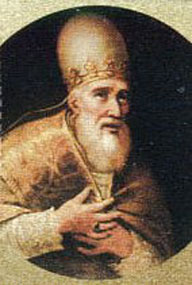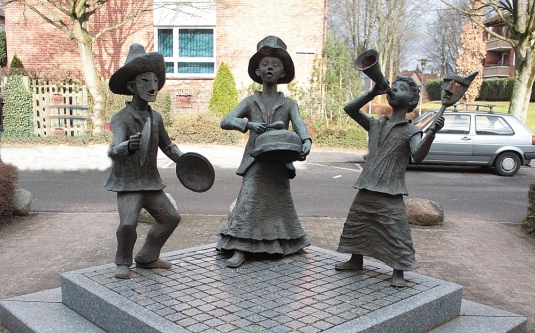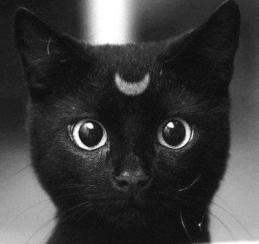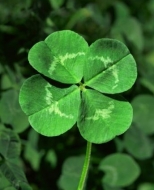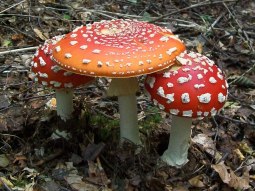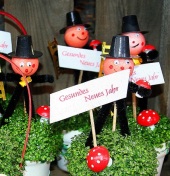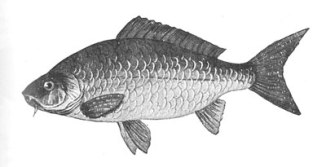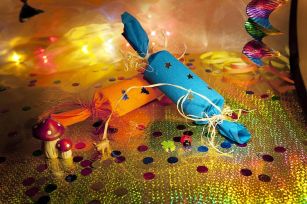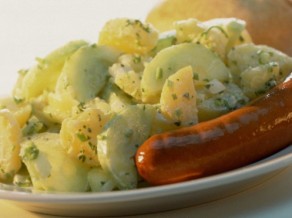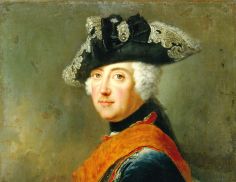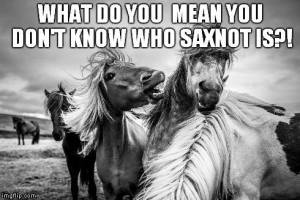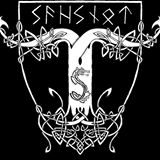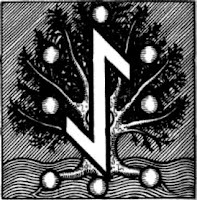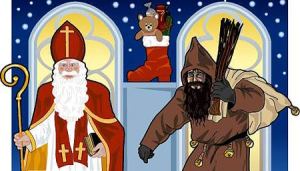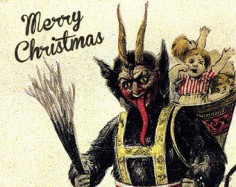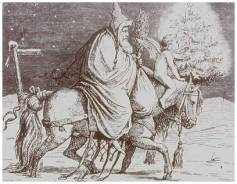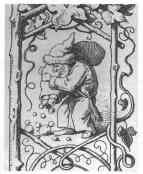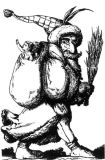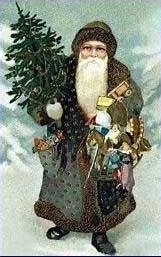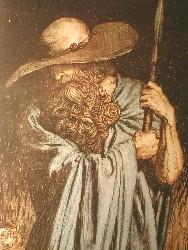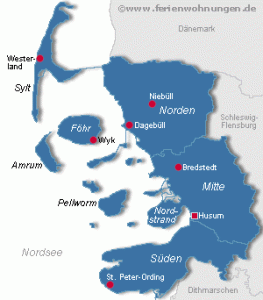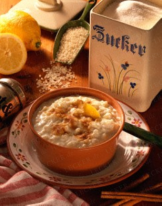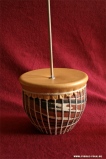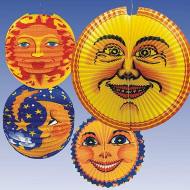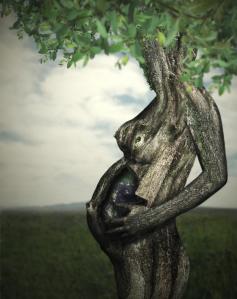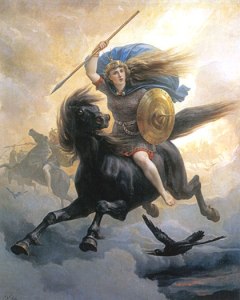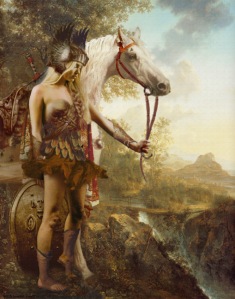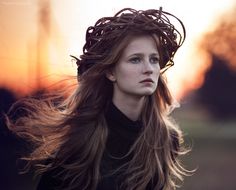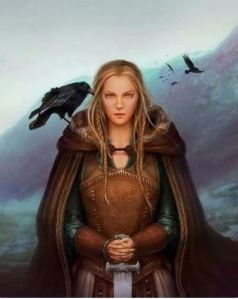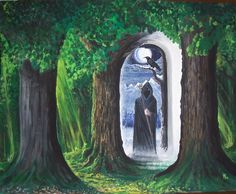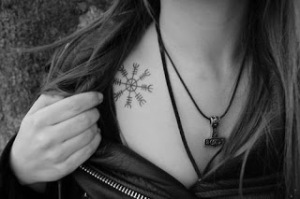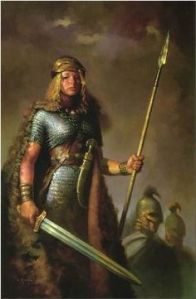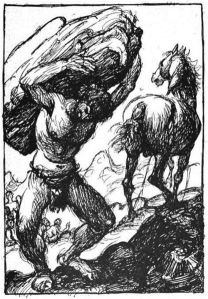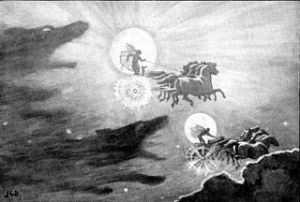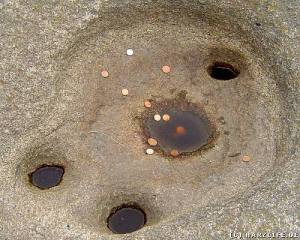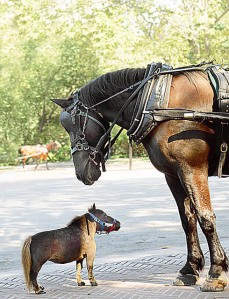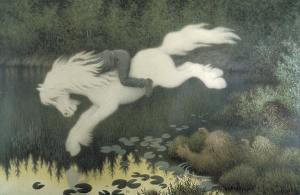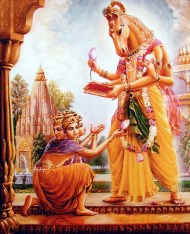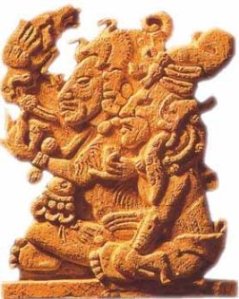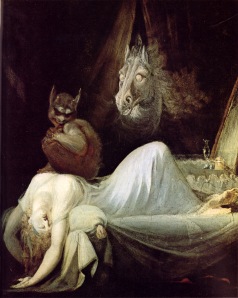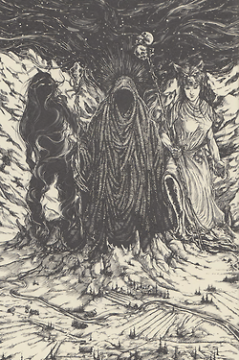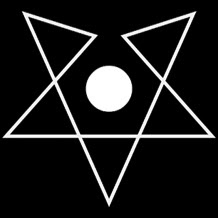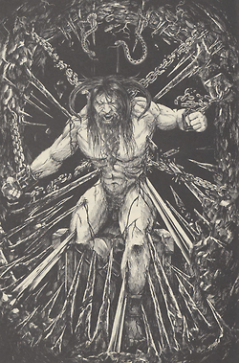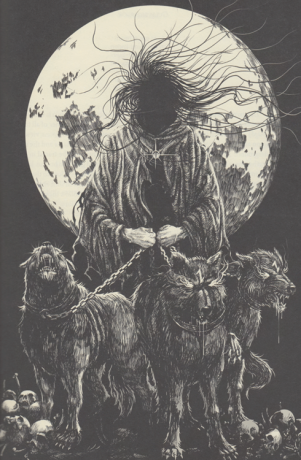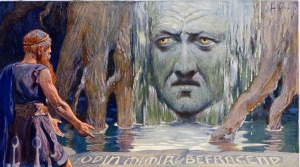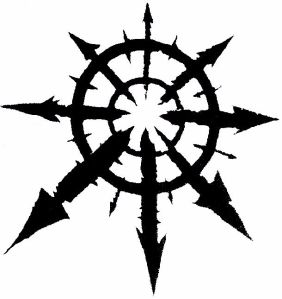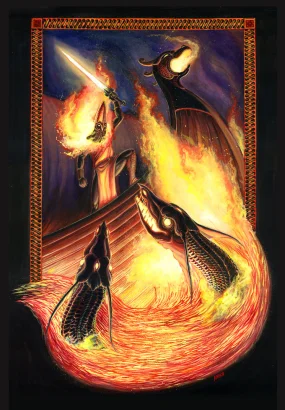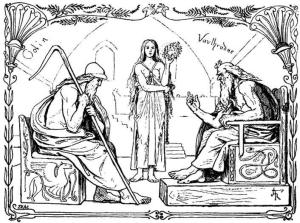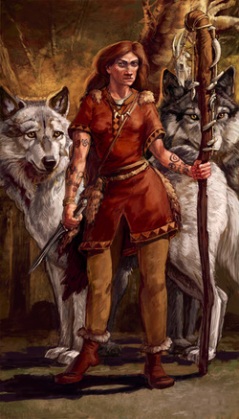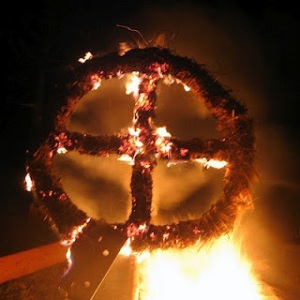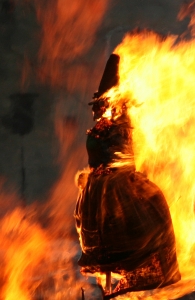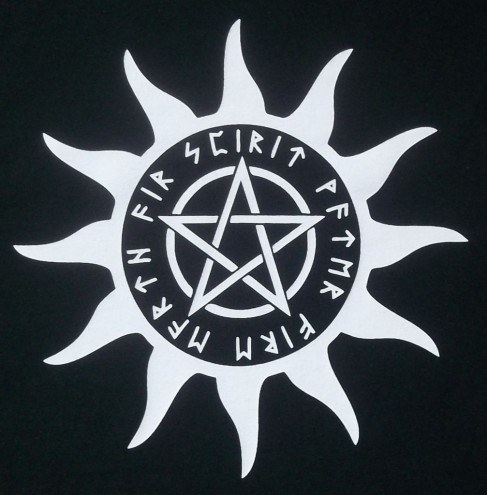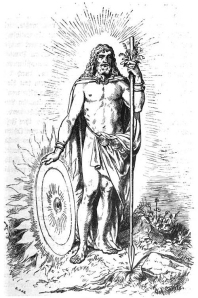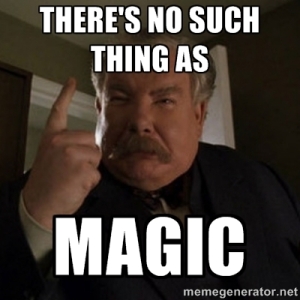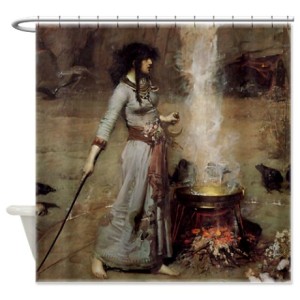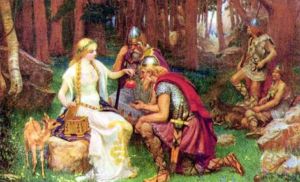
written and copyrighted by Týra Alrune Sahsnotasvriunt
In Germanic and Norse cosmology not Gods came first but Giants. Out of them the multiverse was made, they are at the core essence of everything existent; the primal forces of nature, that – despite being bound to the law and order of the world tree – remain raw and in some ways forever untamed, unbound, evolution unleashed.
That most of mankind and most Germanic Pagans view these forces as “hostile” comes as no surprise, how tiny and insignificant are they in comparison, how powerless and envious.
Just as the Gods created the multiverse by murder thus the majority of mankind copies their actions, intruding, invading and destroying nature and the order of it by any means possible. To conquer and rule these ancient forces is their goal.
Yet once nature retaliates and puts mankind in its place, then the cry is waxen great, to speak in biblical terms.
“Enemies of the Gods”, “world destroyers”, “dumb”, “underdeveloped” “evil”, thus have the Giants been reviled.
All because mankind and Gods are not at the core of their concerns and are but a fraction of it, another wheel in the machinery of life, no more – or less – important than an ant.
Of course neither is all of mankind out to uproot the order of nature nor are all Giants the same. So let us take a look at how versatile these beings, these Primal Gods, truly are.

The murder of Ymir
Etymology
In Old Norse they are called Jotonn, (Swedish Jotun (sg), Jötnar (pl)), the Anglo-Saxons knew them as Eoten and (German) Saxons as Etan or Etin. All of these words are related to the word “to eat” or “hungry” and this is indeed one of the main attributes of the Giants. They are always boundlessly hungry, just like life itself, metaphorically speaking.
Another term for Giant is Thurse, Old Norse þurs (Strength).
The German word “Riese” or Old High German risi or riso, originally wrisi, wriso means the same thing, “strong” or “powerful”. Nowadays the German word “riesig” means “huge”, “gargantuan” though.
The word Hiune (German: Hühne) was first used in Middle High German. It is believed to point to the intermixture between some of the Germanic tribes with the “barbarian Giant-like Huns”, but there is no definitive proof for this assumption.

Runes
Thurisaz is the rune of the incredible strength of the Thursen-Giants. It is also associated with brutish Thunar, slayer of the Thursen and Jöten.
Uruz is the aurochs rune, the rune of the cosmic (“Allmother”) cow Audhumla. It also represents the power of creation and regeneration. For those that equate Audhumla with the Dark Mother figure (Angerboda etc.) Uruz also plays an important role.

Kenaz, the “fire rune” is mostly associated with Loki, sometimes with King Surt or the Giants of Muspili in particular.
In modern times further attempts were made to assign runes to particular Gods and Giants.
For example Hagalaz or Isa are sometimes thought to be Hel’s rune(s), however others believe that Isa is solely Angerboda’s rune and Hagalaz in combination with Thurisaz representative of Ragnarök.
Laguz is linked with Ran or Aegir (and I assume would have to be representative of the Undines and all other “water beings” or beings linked to water, which begs the question whether the Idisen to whom many a pond and lake was dedicated are included in this equation.)

Rökkatrúr believe the Futhorc rune Ac to represent Angerboda, likewise some Rökkatrúr believe that Tiwaz (original chief God Týr’s rune) is a link to the Fenriswolf.
And there are many more examples.
Whatever one may think of reinterpreting and changing a system as ancient and well thought out as the runes everyone must decide for themselves, though.

The Natures and Responsibilities of the Giants
There are Wind-, Weather-, Water-, Mountain-, Forest-, Frost- and Fire Giants and several more.
What all of them have in common is that they “stand as tall as trees and hills”, are usually even-natured unless provoked and keep to themselves and their own kind most of the time.
Plenty of Giant Gods have been described as especially handsome and proportionate.
They do not appear to fit the prejudice of being monstrous, barbarian dim-witted creatures. –

The Thurse Thrym is described as combing his horses’ manes and tending to his dogs with special care.
Gerd is so beautiful that she conquered Wanen God Frey’s heart at first sight.
Thjazi’s daughter Skadi is just as lovely, a skilled and disciplined huntress. She even marries into the Asen line.
Loki’s wit is beyond comparison. If not for him the Asen Gods would not have their most valued weapons and treasures.
Mimir is especially wise, his name translates to “The Pondering”.
Fenja and Menja cannot only see all of the worlds’ past but see the future as well.
And Aegir, Loki’s brother, is a generous host; his feasts are infamous and visited by both giants and Gods alike. He keeps the peace with Thunar even after he calls the Lord of the Sea a slave and inferior to the Asen, insulting Aegir’s hospitability.

Aegir, the “barnteitr”
Whereas certain criteria must be met to be allowed into Wal’s hall, Hel is welcoming to all, no matter how they met their end.
Eggdher is the giant’s watchman, a thorough and meticulous Thurs who is sitting atop a mountain watching for intruders or playing his flute.
Suttung is also known as “Fjalar the Wise”.
Jord/Fjörgyn/Fitjung/Hlödyn is the embodiment of the earth. Is she not all-wise and by being welcoming to all all-loving in her own way?
Wafthrudnir (mighty riddler) is known for his boundless wisdom. The only question he can in fact not answer is what Wotan whispered into Balder’s ear on the latter’s deathbed.
Sunna (sun) and Dag (day) light our days and Mani (moon) and Nott (night) our nights; we have their parents Nör, Mundilfari (world-turner) and Delling to thank for their existence.
Other attributes of the Giant Gods are fjólkunnig and hundvíss (knowledgeable), froþe (smart), ámáttegr (almighty), trolltrygg (faithful as a Giant) meaning faithful till death, something that holds especially true for Sigyn who remained by bound Loki’s side for aeons.

Statue of Fenja and Menja in Odense/Denmark, ~1967
So where does the idea originate that they are dim-witted, underdeveloped and inferior to the Asen and Wanen Gods?
For once the Giants are often known to be barnteitr, happy as children, a term especially attributed to Aegir.
This term at least implies a certain kind of emotional simplicity; as knowledgeable and intelligent as many of them are, they have no interest in the complications that Gods and humans have created for themselves and the rest of the multiverse, be they of emotional or another nature.
Nature itself is rather “simple”; there are few grey areas. Nature’s laws are black and white, they are impartial to a large degree and do not place the well-being and survival of mankind, which is grandiose enough to deem itself special, first.
A good example for this would be Brünhild’s Helvegr (“ride to Hel” in the Elder Edda) on which she is halted by an unnamed Giantess (most likely Modgud). The Giantess speaks:

Modgud, the Giantess that initially refuses to let Brünhild pass
“Depart! You shall not pass though
My tall gates of towering stone:
It befits a wife to wind yarn,
Not to know another’s husband.”
It takes Brünhild a while to explain to the Giantess that she was tricked by evil men and that Siegfried is her true husband, that she belongs with him in death as she would have in life. She did not break any oaths (on her own accord), she did not violate the laws of nature hence. Such treachery, betrayal and cunning is apparently completely unknown to the otherwise rather knowledgeable Giantess, who is not unfamiliar with Brünhild and her fate save for the manmade trials and tribulations.
I often hear people say they wished they could live a simpler life, return or reconnect with nature, far away from the rest of society and its complex systems, only then would they be happy.
This is basically the “Giant life”. To return to nature means to absolutely and unquestioningly submit yourself to the primal and unchangeable forces of life.

In addition to the wise and witty Giants there are indeed those who are not just emotionally but intellectually simpler.
They don’t expect to be cheated and betrayed as they so often are in lore, folk and fairy tales either; they are true to their word, upright and honest and have no ulterior motives hence it is easy to make a fool of them, because they keep repeating their “mistake” of being honest and having no ulterior motives. For a while at least…until they catch on and unleash their terrible (though justified) wrath upon men, the earth and Gods alike.
To call these Giants dumb and insensitive is unjust though. They are the natural urges, the subconscious powers embodied. They, too, play an important role in the cycle of life, even if an uncomfortable one that is harder to comprehend oftentimes.
Their names already speak volumes:

We have Surt (dark), Syrpa (dirty colored), Lodin (shaggy) and Skinnnefja (fur nosed), Hrimgrimnir (frost-grim); all of who might just fit the common criteria for beauty a little less than the Giants mentioned in the second paragraph.
Jarnhaus (iron head), Hardhaus (hard head) and Skalli (skull) sound like stubborn but possibly also quite steady fellows.
A tad more intimidating sounding names are Hardgreip (hard grip), Wolvesmage (wolf stomach – voracious) Hrungnir (constantly hungry one), Hástígi (fast runner).
Many of these Giants are described as multi-headed creatures with dysmorphic proportions and some are alleged to have multiple extremities.
Scholars assume that these originally non-Germanic Giant beliefs may have been influenced by extended contacts with the Orient.
The unruliness and chaotic raw power of these type of Giants is not only displayed in their names but their features also. It is as though the power within is too large for them, fighting to break free again, misshaped their bodies in the process.
These are the Giants, often Thurses, who are responsible for floods, tornadoes, avalanches, tsunamis and other natural disasters. It includes Surt, King of Muspelheim, who longs to burn the world to the ground with his sword of fire. He sits on his throne biding his time until Ragnarök.

King Surt
They all are the cleaning agents of nature, dangerous and sometimes deadly. Hostile? In a way, yet only if you consider death the enemy of life rather than a part of the everlasting cycle.
Personally I have no desire to leave this mortal coil just yet, but I would prefer dying in a natural disaster rather than being shot dead by a thug out to get the 20 Euros in my purse. Fact is mankind is much more hostile towards mankind than nature could ever be.
Nature does everything for a reason whereas mankind acts on whims and trends according to their “Zeitgeist” most of the time.

The Worlds of the Giants plus Utangard and Ginnungagap
The first two worlds were Muspelheim and Nifelheim, realm of ice – Hel’s domain.
On top of these two there is Jötunheim, home to Giants of all tribes. Jötunheim is surrounded by the mountain range Grjótúnagard, where King Thrym and his Thursen folk reside.
Not only are the Giants found in all of the above mentioned realms but also in Midgard (and most likely all other remaining worlds), where they live in boulders, trees, in mountains, in the ocean and deep inside the earth. Again: they are what everything in the multiverse is made of, there is no way of locking them in or out of a world. Their power transcends everything.

Lastly there is Utgard or Utangard, the “outer limits” of Germanic cosmology, home of King Utgard-Loki and more wild Thursen folk.
To make this very clear, Utgard is traditionally not one of the nine worlds, it is considered an Otherrealm by most Germanic and Norse Pagans.
Thursatrú acknowledges eleven worlds of which Utgard and also Ginnungagap are a part. Ginnungagap is the empty space, the great divide, nothingness, in which everything comes undone and is re-assembled before returning to order; the runes for example.
Whether it is a world but rather a state is debatable though I presume.
The same holds true for Utgard. It is not part of the order of the multiverse, something that becomes evident in the traits of its Giants. They appear not to have any of the trolltryggd in them that are innate in their world tree-cousins and are sly and often deceitful too.
Whilst the Yggdrasilian Giants still carry in them the original (Gnostic or primal divine) spark of a state of being before order, they too were forced into shape.
They are known to be able to shape shift in most (or possibly all) cases, but are still bound to the cycle and its order while residing in the multiverse.
Let it be noted that they willingly remain in it as it is made clear throughout the Eddas and other lore that Yggdrasilians and Utgardians can very well cross over into each other’s realities.

Utgardians are free of the cycle and its laws in their realm, but are they free in ours? – Skrymir, who has a run-in with Thunar at the outskirts of Midgard, is often equated with Utgard-Loki. While Thunar is traveling to Utgard, a Giant named Skrymir joins him.
We know that Thunar regularly journeys to Jötunheim to slaughter Giants with his hammer Mjölnir. Never has it been mentioned that Mjölnir did not fulfill its purpose.
Yet when Thunar attempts to murder Skrymir in his sleep three nights in a row he fails. Skrymir’s only comments in the mornings are that he wonders whether a tree leaf, acorn or bird refuse accidentally landed on his face at night, as he is noticing a slight itch on it.
The Utgardians appear to possess greater strength (and slyness) even in our realm.
In their own outer limits they can take shape if they want to, as they did when Thunar and Loki fared to visit them, but they don’t appear to remain in one form for long or only take it on in order to trick the Yggdrasilians visiting Utgard.
The “great Thunderer” Thunar was completely powerless against the Utgardian Thursen. His strength and knowledge was no match for the forces of boundless freedom, formlessness and chaos.
This is why I would view both Ginnungagap as well as Utgard as completely separate from the tree, with qualities and goals that run diametrically opposed to ours.
There is no reason for enmity though; different realities can indeed co-exist without (much) interference and especially without warfare after all.

Utgard-Loki
The Price and Reward of Reintegrating into the Circle
The Eddas, folk tales and later (christianized) German fairy tales are filled with accounts of Giants as great builders, fine constructionists but also brutish simpletons with either rather basic needs or demands beyond human perception.
The story of Blast whose terms of building the walls of Asgard the Gods pretend to agree to, while really plotting to murder him, was already told in https://paganmeltingpot.wordpress.com/2014/09/22/holy-horse-horses-in-the-germanic-and-other-polytheist-traditions/.
Usually these kinds of stories are rather similarly constructed. The Giant agrees to do as he was asked by God or mortal and in return demands the home owner, his virginal daughter or in the case of Blast, the Wanen Goddess Freija as payment.
If we look at this as a metaphor, the meaning could not get much more obvious than this. This is the harsher (sounding) version of three times three.
If you invoke the primal, all-powerful forces of nature you better be prepared to pay the price to keep the balance intact.
Living in accordance with the natural laws, giving yourself to these ancient forces will bring you unimagined knowledge. – But you will lose your metaphorical “virginity”, basically your innocence and ignorance, in the process. There is no turning back. And this is not an easy road to walk.

Grimm’s fairy tale “Das tapfere Schneiderlein”
The trolltrygga – ever-loyal – Giants never breech their contract in lore. They neither lie nor deceive, yet they are merciless in their demands and in their conduct, that much is true.
In the Grimm’s fairy tale Das tapfere Schneiderlein (The brave Tailor) the tailor has a run-in with a Giant who invites him to compete with him. Whilst the Giant plays fairly, the tailor cheats his vis-á-vis in order to win.
Needless to say the tailor is the “hero” in this story, alas, what moral of the story this is supposed to teach us I am not quite sure, but it remains a popular fairy tale nonetheless.

In another Grimm’s fairy tale, Von einem jungen Riesen (Of a Young Giant) a human boy the size of a thumb is adopted by a Giant who feeds him of his own breast milk. 7 years later, when the boy is as tall as his stepfather, the Giant takes him to the forest and asks him to uproot a group of trees. The boy completes the task after some struggle.
Dissatisfied, the Giant takes home the boy again and feeds him for another 7 years until he asks him once more to uproot a group of trees. This continues once more until the boy has become a Giant himself. He returns home to his birth parents. Yet they are terrified of his height and strength and send him away.
In the course of the fairy tale it is emphasized that the once human boy is not just a Giant physically but he has become a Giant emotionally as well.
He finds employment on a farm, but instead of asking for food, shelter or money as payment he asks to strike his employer three times.
Interestingly the farmer agrees to this demand because he does not believe the Giant will complete the chores he assigned him on time. A big mistake.
On payday the farmer attempts to talk the Giant out of the agreed three strikes.
Enraged, the Giant hits his employer so hard he is cast out of sight, far beyond the horizon. The Giant then turns to the farmer’s wife and tells her she will have to pay the rest of her husband’s debt. The terrified woman begs for mercy; in vain.
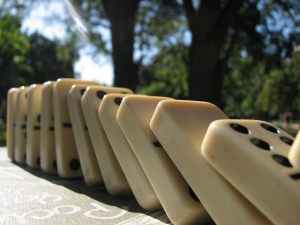
In this story we find another universal law. That energy set in motion will have to discharge somewhere. This is the impartial, seemingly “careless” and merciless side of the Giants (or basically nature itself) mentioned earlier.
Likewise, in the Bible it is written that God will haunt and persecute the children and their children’s children of those breaking the covenant. This is the same principle. This is part of a person’s orlog (family fate) or as the Bible calls it, “original sin”.
Of course not all interactions with Giants demand a hard price to pay. There are also those tales of great reward and friendship between humans and Giants in which their strength is praised but also their meekness and goodness of the heart are emphasized.
In those tales Giants literally cry a river when witnessing the death of small forest animals and give them a worthy burial.
They are the protectors of the forests, tending to wounded animals and nursing them back to health, helping pregnant animals deliver their young, or they uproot dead trees and craft from them nice winter homes for rabbits, birds and other small or larger animals.
Some Forest Giants seek shelter on farms during especially stormy, icy winter nights. Come spring they grant the farmers their protection from spring floods and tend to their fields, granting them a good harvest.

That the forces of nature are always both gentle and cruel, raw and merciful, steady and turbulent is emphasized in the marriage between Aegir and Ran. Aegir interacts friendlily with the Gods and grants good speed to every ship of mortals that he encounters.
His wife Ran (greedy robber) is the exact opposite. The sea witch in the fairy tale “The Little Mermaid” is based on her and like the original she collects unlucky souls and offers unholy contracts.
Ran herself sinks ships and forces sailors to live in her dark, wet, chilly hall. Neither Gods nor men interest her much if they don’t do as she pleases. The sea is both friend and foe to humans and especially seafarers.

Ran
Animal Giants
The most popular animal Giants are probably the Fenriswolf and Jörmungand, the Midgard Serpent. Fenris’ only crime was to grow swiftly in size and be insanely hungry at all times, gladly devouring everything the Asen Gods presented him with.
A great appetite is not exactly unusual for Giants, yet fearing young Fenris’ great strength and that they might be overthrown, the Asen Gods tricked and bound him.
In the process they betrayed and dismembered one of their own, Týr, who had given his word to Fenris that he would not be harmed.

Hel, Fenris and Jörmungand
Jörmungand (from Old Norse jormun = Mighty and gandr = staff/wand) is sometimes described as curling around Midgard after he was thrown so carelessly into the sea by the Asen Gods.
Neither is Jörmungand’s sex mentioned nor are there any accounts about it other than a short notion that Thunar will slay the great serpent during Ragnarök and that he is known to go and stir it, poking, prodding and beating at it without much success – and most importantly – without point nor apparent reason.
Jörmungand could easily plague if not annihilate Midgard if it is large enough to curl around it. However, it doesn’t cause much trouble other than stir the sea at times and feed off careless sailors. Only when provoked by Thunar does Jörmungand display its true might.
(Although it might be concluded that – Jörmungand aside – generally minimizing the giant population as Thunar regularly does or “keeping the forces of unbound evolution in check” is a way of ensuring at least some form of stability and keeping the powers in “balance” for now.)

Jörmungand, the “Mighty Staff”
In order to trick Jörmungand into thinking that it was just another sea serpent gliding through the waters rather than a boat full of mortals, the Vikings’ figurehead was a serpent head.
It is interesting that save for Loki’s only humanoid daughter with Angerboda, Hel, all of his children are bound in some form or another. Jörmungand is basically being “bound” around the countries of this earth and forced to eat its own tail.
Fenrir is bound by magically crafted rope.
Nari and Narfi are not bound but their intestines are used to bind Loki after Balder’s death.
Obviously, the binding of all these above-mentioned Giants was not very conductive to the survival of the Asen in the very end, but maybe they knew this and their story is not the Greek tragedy it appears to be at first sight. If they are the “Gods of consciousness” they will most likely be aware that a multiverse created the way it was would end (or keep repeating itself) in the same way.

Ironwood
There are also the wolves of Ironwood, Angerboda’s other children. She nurses and prepares them until it is time for the end battle.
Her wolverine sons Skoll (greedy) and Hati (hateful) roam the skies, hunting Sunna, the sun, and Mani, the moon. For now we will have to thank them for chasing after the two, for Sunna and Mani had been too vain and lazy to shine their lights upon Gods, Giants, wights and men. If not for Loki who unleashed Skoll and Hati on them, we would all sit in eternal darkness now.
Skoll is so gargantuan that he will swallow Sunna whole, come Ragnarök. Luckily “Elf Candle” as she is also known, bore a child before her death, who will illuminate the New World.

Nidhögg with messenger squirrel Ratatösk
The Storm and Weather Giant Hräsvelg (corpse-eater) is sitting atop the world tree, causing both storm as well as gentle breeze when flapping his wings.
The serpent (dragon) Nidhögg (low cowerer) curls around the base of the Yggdrasil, chewing at its roots. Nidhögg and Hräsvelg do not grow tired of throwing insults back and forth at each other. Alas they are so far away from each other on the tree that the squirrel Ratatösk keeps running back and forth between them, delivering their snarky messages.
Eight-legged Sleipnir is the size of a regular horse, yet since both his parents are the newly-called “Rökkr”-Giants (a term I’m not opposed to but that should be mentioned is not historical) what else would he be? He is well-liked by Germanic and Norse Pagans while his siblings are usually condemned and hated. Yet…it is Sleipnir that carries Wotan towards his death, his brother Fenrir will devour that once foreign and most likely originally Eastern/Slavic God.

All these animal Giants appear not to be able to change shape. The Giants born into humanoid shape are often described as transforming into animals though.
Loki regularly turns into a fox.
Thjazi transforms into a Giant eagle.
Fafnir on the other hand used to be human and later changed himself into the grisly dragon that Siegfried slew.
Grendel might just be a kind of Giant, he is described as a strange blend between animal and human.
Is it supposed to tell us something that the animal Giants cannot change shape? Do they possess less power? Or are they more primal and hence powerful in turn, more Giant-like in nature because they are all instinct without complicated thoughts confusing them?
All of the above mentioned play a pivotal role in Ragnarök, without them the cycle could not be ended, a new cycle could not be begun.

Storm Jotun
Historical and Modern Giant Cult
Ich paut dir Fasolt, dass du das wetter verfirst mir und meinen nachpauren ân schaden.
(“I beg you, Fasolt, that you grant me good weather and keep harm from my neighbors and me”).
Thus goes an ancient German prayer to Storm- and Weather Giant Fasolt.
To say that there are no traces of a historical Giant cult or of Giant veneration is not completely correct hence. There are – admittedly scarce – traces in the fairy tales and in classical lore as mentioned before. One other example is the prayer of Thorvald Holbark to Surt (!) in Landnamabók.
Save for the above weather blessing and a few vardulokkur and galdralát as sung in Seid rituals – such as the Buslabaen – there are however few testimonies that Giants were called upon. Which is not to say that they could not have existed, a lot got lost in the course of christianization after all.
One German(ic) incantation to stop heavy bleedings addresses “Tumbo” (unfeeling, silent, the name of a Stone Giant). It speaks of how Tumbo is sitting in a mountain with a child in his arms. The Giant is being flattered by calling him “holy” and then asked to close the wound.
Whether this charm or prayer was tied to the rock formation of a specific location that looked like a Giant holding a child cannot be determined anymore.
It’s possible that just like the German Horse Blessing there are forgotten allegories or metaphors we just cannot decipher anymore nowadays.

Even if there had never been a historical Giant cult, who says they cannot or should not be venerated? They have truly remained trolltrygg and have kept this world alive and still in relative balance despite what we have done and continue to do to it. For this alone they deserve the utmost respect that they were so long denied.

Their path is one of selflessness. They know of their personal futures, of their fates, and yet they accept it, working towards the next great leap in evolution (Ragnarök) without fear or regret. Nature itself cannot die. Nothing can. There is no death, only transformation.
The Asen are fighting so that there will be something left after our world has been burned, that is their role and they fulfill it just as dutifully. They are the stabilizing forces, without the giants they would represent stagnation. Without the Asen the giants would be “Utangardian”, unpredictable and most likely utterly dangerous.
If you praise the Asen and the Wanen, blot to the Alben, toast the dwarves, bow to the Idisen and give a nightly thanks to your Fylgja, yes, even give an acknowledging nod to Hel around the time of the second Idisenblot, do not be a hypocrite and shun or ignore those forces this world was made of and still essentially consists of. Hail the Giants!


